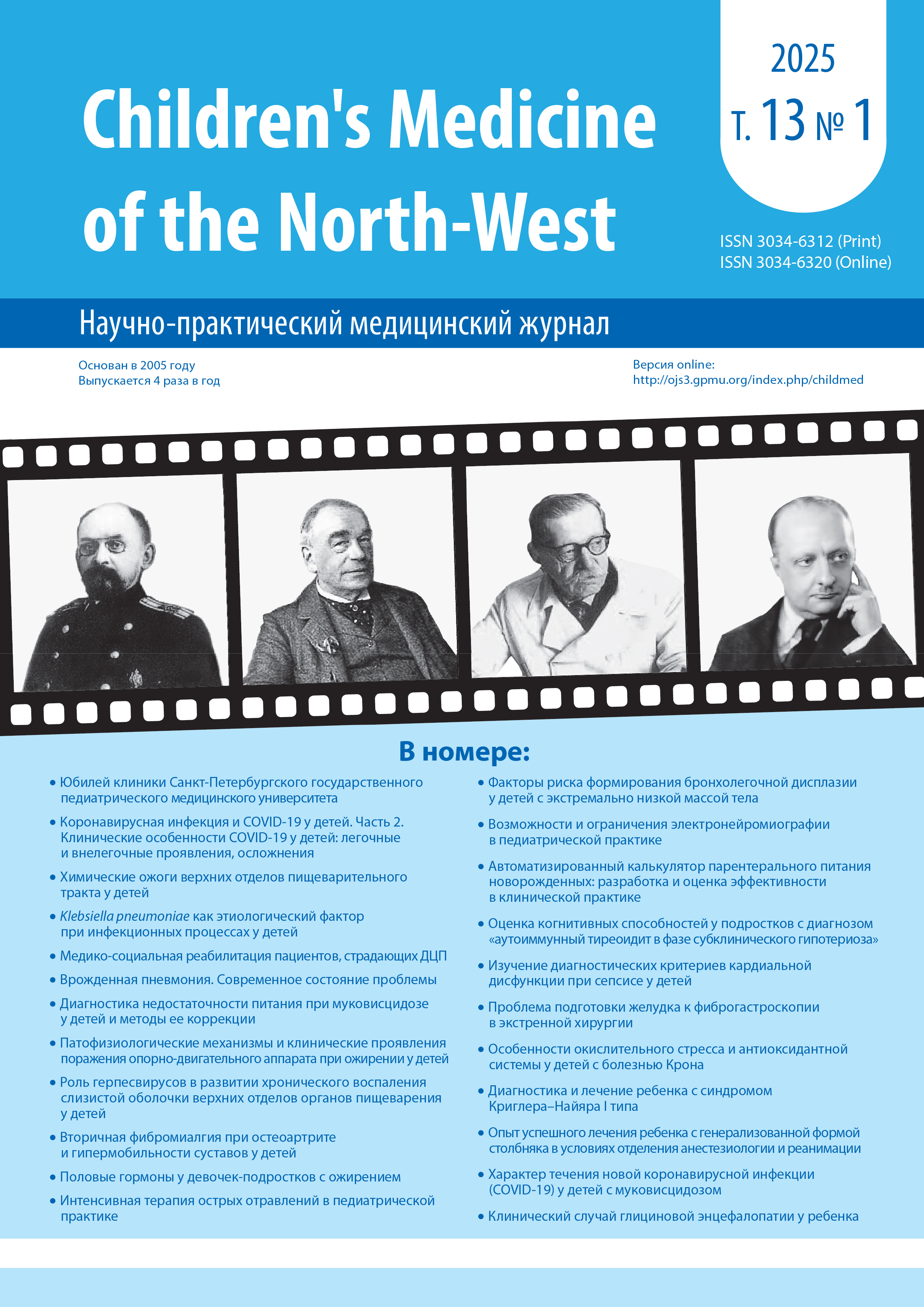THE NATURE OF THE COURSE OF THE NEW CORONAVIRUS INFECTION (COVID-19) IN CHILDREN WITH CYSTIC FIBROSIS (CLINICAL CASES)
Abstract
A new coronavirus infection (COVID-19) was first reported in late 2019 in Wuhan (China). In March 2020, the World Health Organization (WHO) announced a pandemic. The incidence in children aged 0 to 17 years accounts for 10 to 20% of cases worldwide. COVID-19 in children and adolescents is more often asymptomatic or as a mild form of acute respiratory infection, which is probably due to the low incidence of chronic diseases in children, a lower prevalence of cells with ACE2, which SARS-CoV-2 uses to infect. Alveolar type II cells are the main targets for this virus, resulting in the development of diffuse alveolar damage. The presence of various concomitant pathology can aggravate the course of viral infections to the development of acute respiratory failure and death. In particular, children with pathology of the bronchopulmonary system, such as chronic obstructive pulmonary disease and interstitial lung diseases, are at maximum risk of infection. However, based on literature sources, there is a hypothesis that in many patients with impaired immune mechanisms, the presence of chronic lung diseases, COVID-19 may proceed relatively favorably and with a lower risk of complications. Due to the fact that the acute course of COVID-19 is characterized by the appearance of fever, catarrhal syndrome and damage to the lung tissue, the primary differential diagnosis in patients with pathology of the bronchopulmonary system has certain difficulties, since these clinical manifestations are primarily regarded as an exacerbation of a chronic process. In this regard, we analyzed cases of acute COVID-19 in 2 girls aged 16 and 5 with cystic fibrosis, and identified clinical and laboratory factors affecting both the severity of COVID-19 disease and cystic fibrosis.
References
Временные методические рекомендации МЗ РФ «Профилактика, диагностика и лечение новой коронавирусной инфекции (COVID-19)». Версия 18 (26.10.2023).
Государственный доклад «О состоянии санитарно-эпидемиологического благополучия населения в Российской Федерации в 2021 году». М.: Федеральная служба по надзору в сфере защиты прав потребителей и благополучия человека; 2022.
Методические рекомендации «Особенности клинических проявлений и лечения заболевания, вызванного новой коронавирусной инфекцией (COVID-19) у детей». Версия 2 (03.07.2020).
Иванов Д.О., Заболотский Д.В., Корячкин В.А. и др. Лечение детей, инфицированных COVID-19, в непрофильном стационаре. Педиатр. 2020;11(2):5–14. DOI: 10.17816/PED1125-14.
Иванов Д.О., Петренко Ю.В., Резник В.А. и др. Дети ковидом не болеют… Заметки из красной зоны Педиатрического университета. Под ред. Д.О. Иванова. СПб.: СПбГПМУ; 2022.
Баннова С.Л., Иванов Д.О., Александрович Ю.С. и др. Особенности тяжелых форм новой коронавирусной инфекции (COVID-19) у детей. Педиатр. 2023;14(5):5–13. DOI: 10.17816/PED625937.
Клинические рекомендации. Кистозный фиброз (муковисцидоз). М.: Министерство здравоохранения Российской Федерации; 2021.
Кондратьева Е.И., Красовский С.А., Каширская Н.Ю. и др. COVID-19 у больных муковисцидозом. Пульмонология. 2020;30(5):544–552. DOI: 10.18093/0869-0189-2020-30-5-544-552.
Majka G., Mazurek H., Strus M. et al. Chronic bacterial pulmonary infections in advanced cystic fibrosis differently affect the level of sputum neutrophil elastase, IL-8 and IL-6. Clin. Exp. Immunol. 2021;205(3):391–405. DOI: 10.1111/cei.13624.
Климов Л.Я., Кондратьева Е.И., Ильенкова Н.А. Особенности врожденного иммунитета на фоне хронической инфекции респираторного тракта у детей с муковисцидозом. Педиатрия. Consilium Medicum. 2019;1:59–66. DOI: 10.26442/26586630.2019.1.190198.
Hamad S.G., Kammouh H., Alamri M., Zahraldin K. The clinical features and impact of SARS-CoV-2/COVID-19 infection in children. Qatar Med J. 2023;2023(3):19. DOI: 10.5339/qmj.2023.19.
Lotti V., Merigo F., Lagni A. et al. CFTR Modulation reduces SARS-CoV-2 infection in human bronchial epithelial cells. Cells. 2022;11(8):1347. DOI: 10.3390/cells11081347.
Bain R., Cosgriff R., Zampoli M. et al. Clinical characteristics of SARS-CoV-2 infection in children with cystic fibrosis: An international observational study. J Cyst Fibros. 2021;20(1):25–30. DOI: 10.1016/j.jcf.2020.11.021.
Abolhasani F.S., Moein M., Rezaie N. et al. Occurrence of COVID-19 in cystic fibrosis patients: a review. Frontiers in Microbiology. 2024:1–12. DOI: 10.3389/fmicb.2024.1356926.
ECFS. COVID-CF project in Europe. Available at: https:// www.ecfs.eu/covid-cf-project-europe (accessed: June 2, 2020).
Cosgriff R., Ahern S., Bell S.C. et al. A multinational report to characterise SARS-CoV-2 infection in people with cystic fibrosis. J. Cyst. Fibros. 2020;19(3):355–358. DOI: 10.1016/j.jcf.2020.04.012.
Mondejar-Lopez P., Quintana-Gallego E., Giron-Moreno R.M. et al. Impact of SARS-CoV-2 infection in patients with cystic fibrosis in Spain: Incidence and results of the national CF-COVID19-Spain survey. Respiratory Medicine. 2020;170:106062. DOI: 10.1016/j.rmed.2020.106062.
Слесарева Е.Г., Сарана А.М., Щербак С.Г., Вологжанин Д.А., Голота А. С., Камилова Т. А. Влияние бронхолегочных заболеваний на течение и исход COVID-19: обзор литературы. Juvenis Scientia. 2024;10(4):19–28. DOI: 10.32415/jscientia_2024_10_4_19-28. EDN: MYVXJU.
Di Cicco M., Tozzi M. G., Ragazzo V. et al. Chronic respiratory diseases other than asthma in children: the COVID-19 tsunami. Ital J Pediatr. 2021;47:220. DOI: 10.1186/s13052-021-01155-9.



